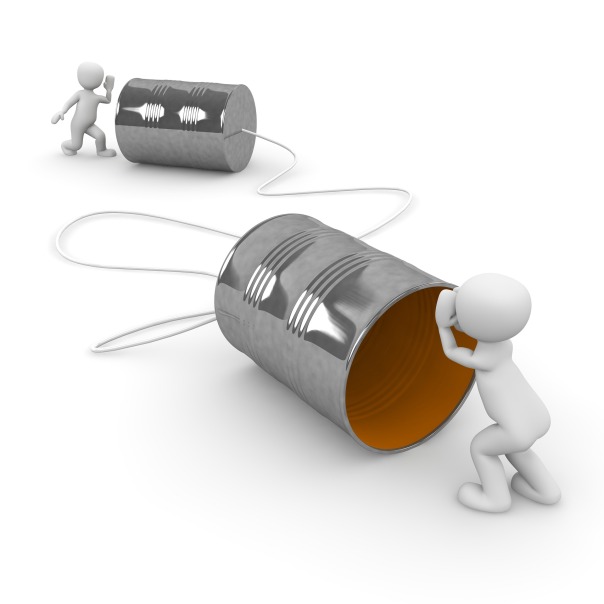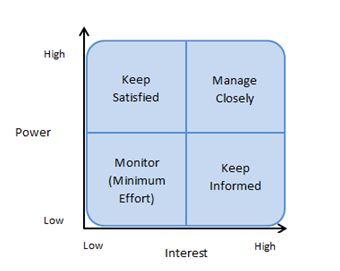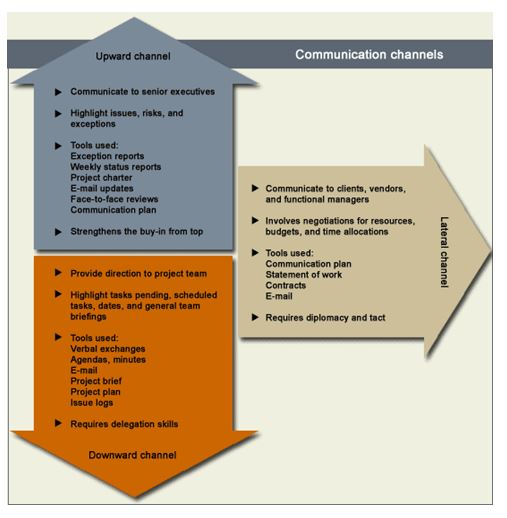Effective Communication in Project Management

Ineffective communication causes one-half of all unsuccessful projects (Foong, 2014). Because of this, project managers need to develop communication plans at the onset of their projects. This plan is designed to ensure all stakeholders are engaged and informed at the appropriate level and through the most efficient means of communication. Foong (2014) suggests using a “Power vs. Interest” matrix to guide the development of your communication plan. This matrix (figure 1) will help determine at what level each stakeholder should be engaged and informed.

Figure 1: Power/Interest grid from https://www.projecttimes.com/articles/effective-communication-a-challenge-to-project-managers.html
Foong’s matrix strategy complies with Charvat’s suggested communication channels (2002). Charvat’s channels of communication outline how and to what level communication should occur with all levels of stakeholders, see figure 2.

Figure 2: Communication Channels from http://www.techrepublic.com/article/project-communications-a-plan-for-getting-your-message-across/
Colorado State University’s “Tips for Developing your Communication Skills” highlights the importance of knowing your audience – find out what modality works best for all parties involved (Learn Effective Communication Strategies in the Workplace, 2015). The modality of communication can greatly impact the success of your project in multiple ways. The intentions of written communication can be misinterpreted. For example, a message conveyed in writing may not be perceived as urgent as the same message conveyed face-to-face. You may also find that some recipient will not respond as quickly via email as they will with a short informal meeting.
Most communication issues can be avoided if an effective communication plan is put into place. The communication plan will set the expectation for how communication will flow into and out of the project, how often communications will occur, and by what modality communication will take place. Charvat (2002) explains how too much or too little communication can hinder a project. A proper communication plan can circumvent this problem.
References:
Charvat, J. (2002, November 13). Project communications: A plan for getting your message across – TechRepublic. Retrieved July 12, 2016, from http://www.techrepublic.com/article/project-communications-a-plan-for-getting-your-message-across/
Foong, M. Y. (2014, April 09). Effective Communication: A Challenge to Project Managers. Retrieved July 12, 2016, from https://www.projecttimes.com/articles/effective-communication-a-challenge-to-project-managers.html
Learn Effective Communication Strategies in the Workplace. (2015, February 12). Retrieved July 12, 2016, from https://csuglobal.edu/blog/make-indispensable-5-workplace-communication-strategies
Posted on July 12, 2016, in Uncategorized. Bookmark the permalink. 3 Comments.
Excellent post, Natasha. The graphic elements you used, such as Foong’s matrix, were ineresting and engaging, and they helped illustrate the concept being discussed. You also raise a great point about finding out what mode of communication works best for the stakeholders you will be dealing with. Different people have their preferred methods of communication, and the message will be more likely to be understood and appreciated when sent in the recipient’s preferred method. You can definitely see why experts recommend holding a meeting close to lay out the ground rules for communications between team members, as well as between team members and stake holders (Laureate Education, n.d.).
References:
Laureate Education, Inc. (Executive Producer). (n.d.). Communicating with stakeholders [Video file]. Retrieved from https://class.waldenu.edu
LikeLike
I agree with Garth, the images definitely enhance the post. It’s funny, with all the projects I worked, I never really put together a formal communication plan, but I can definitely see how it would have made my life and those around me easier. It’s kind of like applying ISD, to some extent, all teachers put thought into which is the best way to teach a concept, but applying ISD means you have a roadmap instead of simply fumbling around. A communication plan acts in the same way, providing the project manager with a road map instead of fumbling around trying to guess who needs what information. Great post!
LikeLike
Great post and use of images. I felt that they added when to what you were saying. Your conclusion was also well phrased when you said, “most communication issues can be avoided if an effective communication plan is put into place. The communication plan will set the expectation for how communication will flow into and out of the project, how often communications will occur, and by what modality communication will take place.” This is a great model to use.
LikeLike